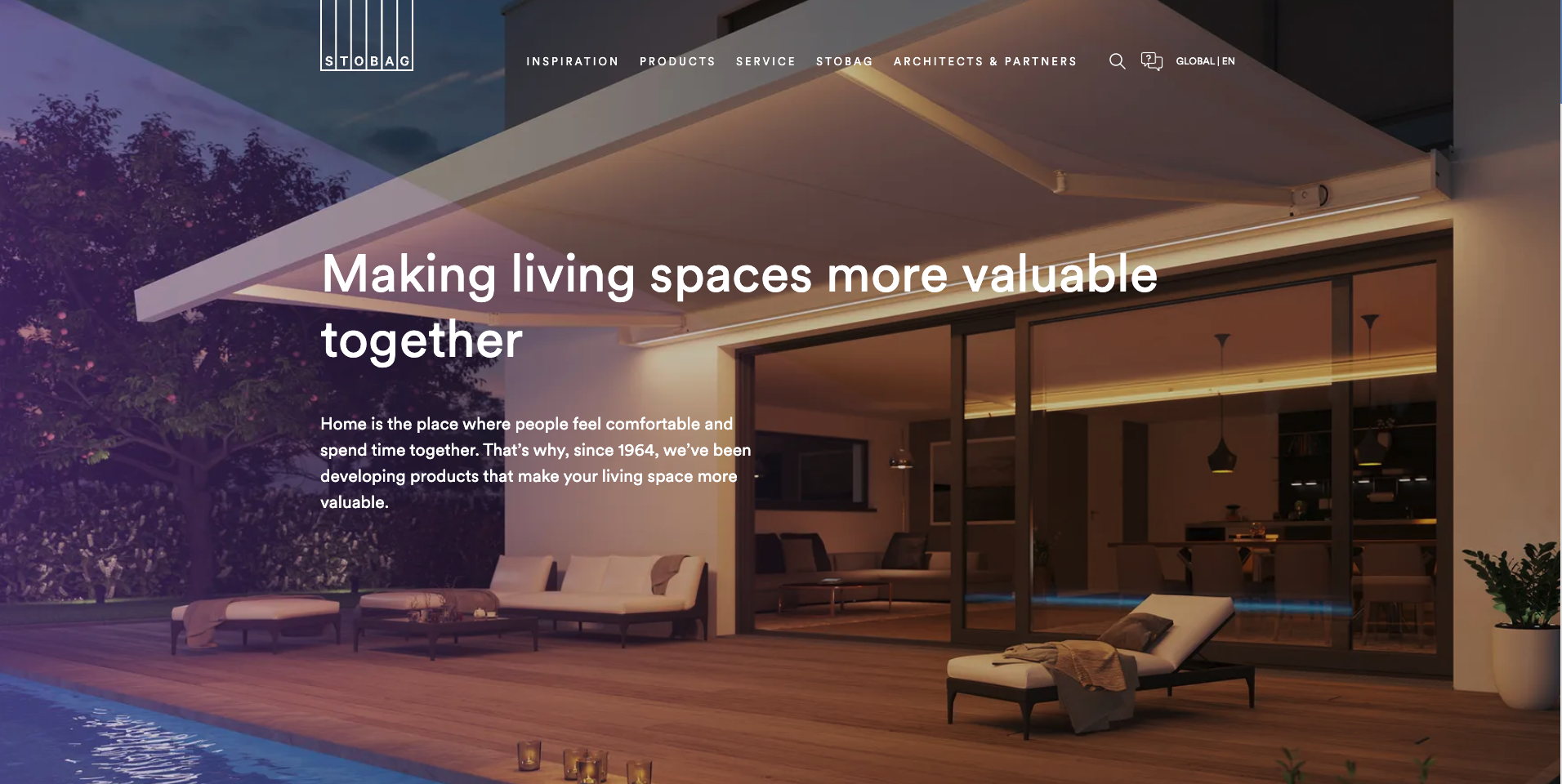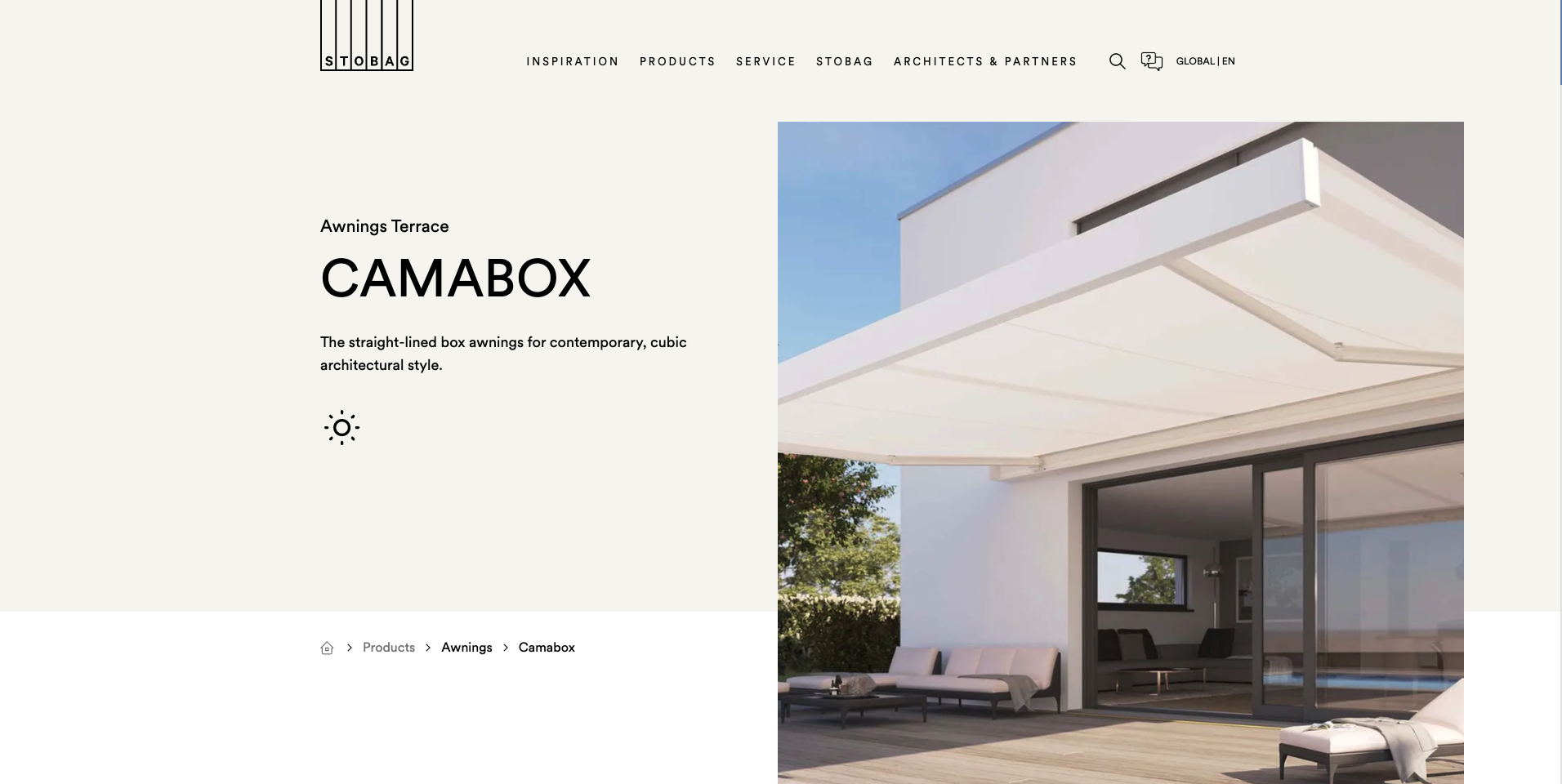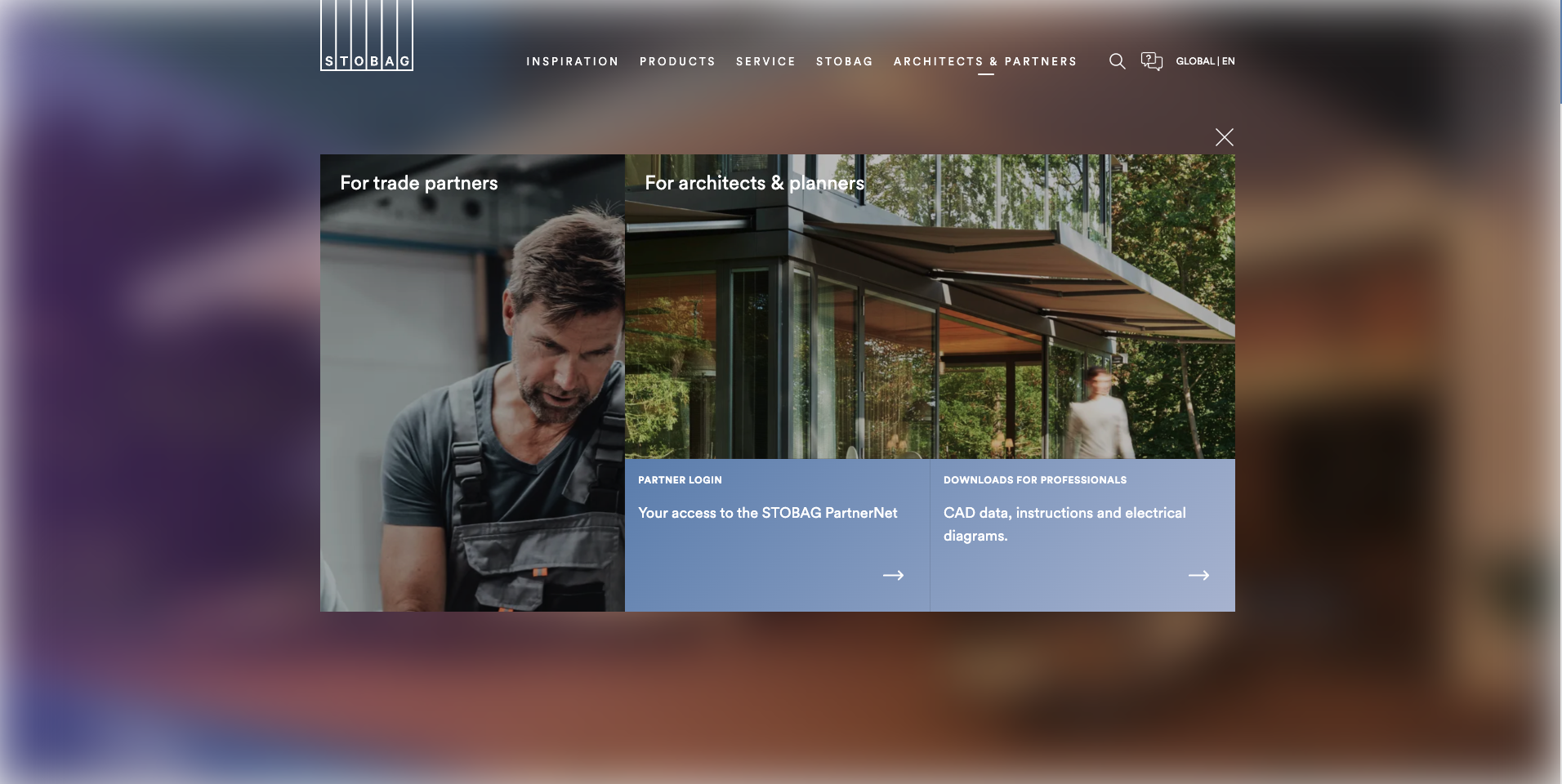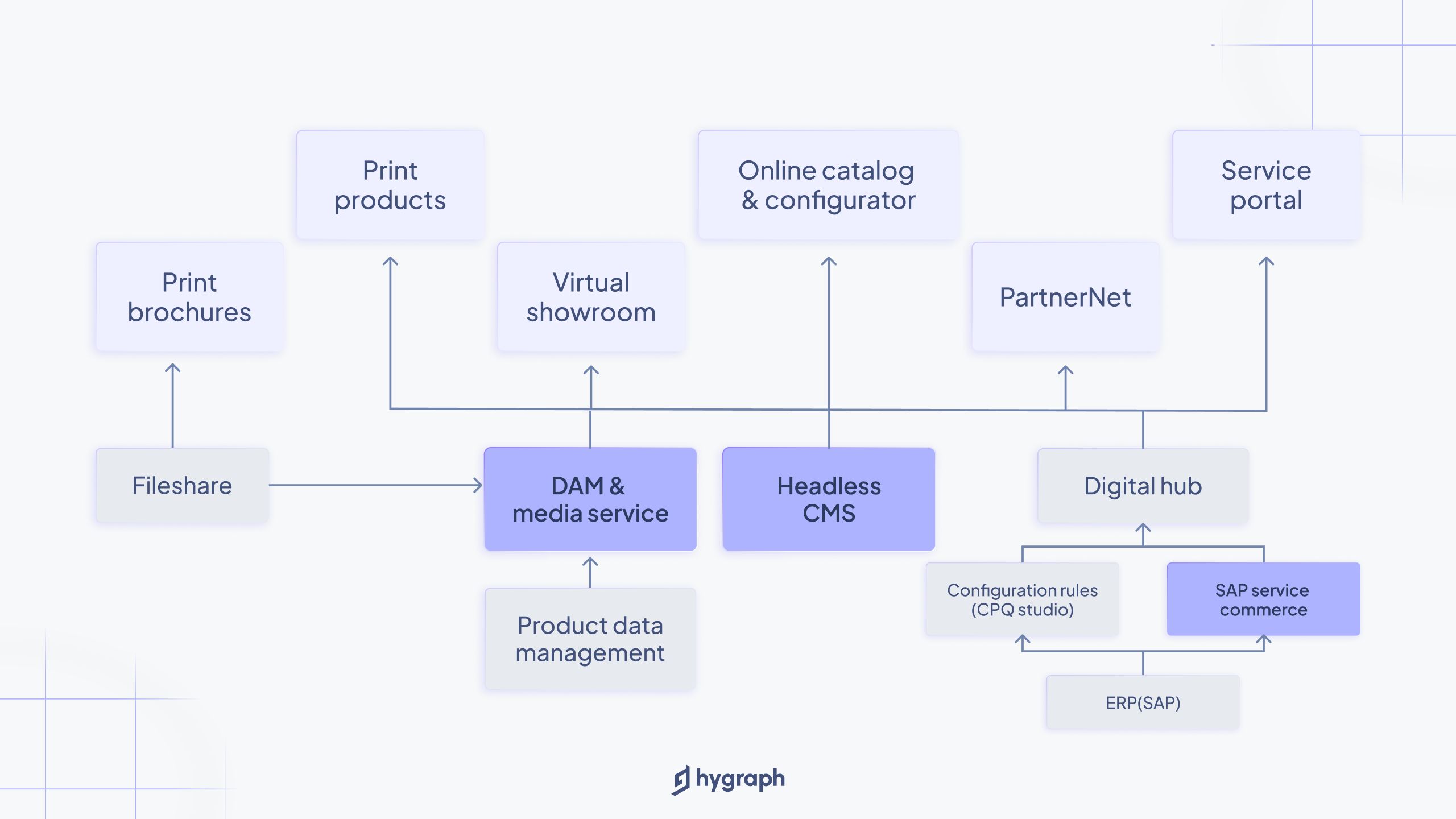The Stobag story
Your home is where you should feel comfortable and spend quality time. This is something Stobag firmly believes. Stobag has been developing and selling sun and weather protection products to bring this vision to life since 1964.
However, advancements in modern living have also impacted how we buy weather protection solutions. Traditionally, you needed to see product information in printed brochures, visit showrooms, and pick fabric samples in person. Now, you can get technical information about the products online and configure them according to your preferences.
That's why Stobag set out to seek digital transformation to match their business offers to a modern way of home living. For over 50 years, Stobag has relied on printed materials to help customers and partners choose between its various products. Today, Stobag strives to provide customers and partners with the most relevant information and the best online ordering experience.
To accomplish this goal, Stobag had to resolve a fragmented data landscape and create a unified content layer. Previously, Stobag's website was only a complementary marketing tool. It had a mix of B2B and B2C content.
Furthermore, product information was stored across siloed sources like Excel, InDesign, and on-premise PIM, making it difficult to access and use effectively to create business value.
To build the public website and the integrated customer portal, Stobag partnered with Intelliact. The pair opted for a headless approach to manage content on various apps and frontends, ensuring it is displayed at the appropriate time and place. Hygraph was chosen as the headless CMS to facilitate Stobag's digital transformation and easy content creation. As a result of Stobag's digital transformation, their online revenue has increased from 15% to 70% of their company share.
Project challenges
Hard to manage content with scattered legacy systems
Stobag used to primarily rely on printing, resulting in scattered information across different platforms like web CMS, InDesign files, and other documents. This led to content silos and difficulties in content management. For instance, certain information could only be accessed through an InDesign file and was not available elsewhere or retrievable via API.
This technical limitation forced Stobag to duplicate content whenever it was in a different context. This resulted in the same information being kept in multiple locations, necessitating updates being made in one place and replicated across others. Furthermore, this created a bottleneck in content updates, as the person with access to the InDesign file ultimately became the gatekeeper.
Digital transformation blocked by contentsilos
Agile digital customer experience is about providing the right content at the right time and place. The challenge faced by Stobag was repurposing existing content and targeting diverse audiences efficiently. For instance, instead of physically printing and mailing catalogs and price lists, providing consumers with online access to information and product configuration options on the company's website is more efficient.
To stay competitive in today's market, companies must offer fast and convenient customer ordering processes. Stobag's limited and inconsistent use of product information made it impossible to leverage and build value-added features like a product configurator. Such features could only be built if they had content in module blocks that could be arranged differently.
Project objectives
Agile content delivery with a headless approach
Stobag envisions a future where they could enable many-to-many content relationships, as they see an increasing need to present the same information in several locations and pull data from different sources. They seek a unified content layer to consolidate scattered content across multiple channels and be the single source of truth.
The headless approach enables the retrieval of content via APIs, which helps to break down silos and allows the same content to be reused in multiple locations. Since this approach provides infinite ways to present content throughout the customer journey, Stobag has decided it is the optimal choice for them.
Manage and request content in a structured way
This project strives to separate B2B and B2C content with maximized content reusability. Developers at Stobag and Intelliact required a solution that can not only manage content but also allow requests in a structured manner. The content needs to be delivered to different audiences in different locations through API. Therefore, Stobag's top priority when searching for a headless CMS was the availability of GraphQL.
Meanwhile, to manage the content publishing process effectively, features like translation management, content review workflows, and mass mutations were also crucial requirements.
Hygraph’s solution:
Together with Intelliact, Stobag researched the market and shortlisted two headless CMSs, Hygraph and Contentful.
Following an extensive evaluation, Stobag and Intelliact chose Hygraph for its strong GraphQL API.
They trusted that Hygraph's deeply nested GraphQL queries would give them more flexibility in structuring and getting back structured content as they query it. Other considerations included the image manipulation endpoint and cost-effectiveness. Furthermore, Stobag enjoyed working with Hygraph because of its accountable product roadmap and timely support.
Here are the features that were critical to delivering the project successfully.
Robust GraphQL API
Hygraph's GraphQL capability met all of Stobag's requirements for success on the project. The GraphQL interface has all the content in the right shape to consume for each use case, which makes it different from other CMSs. Developers can query the data needed in a structured way and combine all queries together to reduce requests while maximizing performance.
Highly structured content model
With Hygraph, Stobag can manage and consume highly structured content with a relational data model rather than rich text. Unlike most headless CMSs that are page-based, Hygraph stores content with a modular approach; ready to be reused for multiple purposes across channels.
Despite being software as a service, Hygraph is not like the typical software as a service where everything's anonymous and vague. There's still a connection and the relation with the Hygraph team when we need support.
Marco Egli
Senior Consultant, Intelliact AG


The current setup
In rolling out the implementation, Intelliact created the data models, the structure, the schema, and showed the Stobag team how to use GraphQL APIs. Then Stobag took over the use of Hygraph.
Inside the Stobag organization, the IT department handles all infrastructure, consumes Hygraph content, and integrates it into different frontend systems. The Product Management team is responsible for feeding content into Hygraph.
Stobag and Intelliact developed the B2B customer portal "PartnerNet" and the B2C public website using two Hygraph projects, one managing general marketing content and the other acting as a product information database. Aside from technical content and mass data that comes from systems like SAP, Hygraph is becoming Stobag's single source of truth for product information and marketing content.
Here’s a closer look at Stobag use cases:
Product information system
Stobag is currently consolidating product information into Hygraph and plans to replace the legacy PIM applications eventually. The product information stored in Hygraph enables Stobag to leverage APIs for content reusability. This is critical to the customer journey, as product information is used in several touchpoints to support dealers.
The product information is used, for instance, in PartnerNet's eCommerce configurator. Stobag uses Hygraph to display and add product information for configuration attributes before customers purchase the products. Stobag describes the attributes within Hygraph and calls the right information during product configuration.
Stobag also uses Hygraph in several other ways to maintain good relationships with dealers. For example, Stobag now offers a feature that automatically updates dealer sites with product information from Stobag. The company also developed a fabric ordering tool that acts as a lead magnet, offering customers the option of ordering samples and setting up appointments with showrooms and then handing the leads over to dealers.
Website content management
Structured content allows Stobag to have a clear separation of B2B and B2C content now. This helps them be closer to the end customers and target them directly. The Hygraph headless CMS, on the other hand, has the advantage of interconnecting content between B2C and B2B use cases. This eliminates unnecessary time spent maintaining content.

The tech stack
Inside the Stobag tech stack, Hygraph headless CMS replaced the legacy system and fetched content from existing sources via APIs. SAP is the ERP system and hosts the master data. The frontend applications source information directly from SAP and other systems. Stobag uses CPQ software for the runtime environment to build the configurator inside PartnerNet on the web. Several other systems, such as CRM, are also involved in the customer journey.
As the migration moves along, Stobag will aggregate all non-technical information in Hygraph. SAP will remain the host for technical master data, while Hygraph will become the single source of truth for all other information.

The results and key benefits
By launching the new website and customer portal, Stobag has improved its content landscape and refreshed its brand identity. Through its online presence, Stobag now offers a seamless customer journey from B2C to B2B and has transformed its print-first business into a digital one.
Refreshed brand identity
Stobag not only launched a new website with this project but also refreshed the branding to align with their brand values. The content for B2B and B2C is now well-separated, reducing the need for unnecessary content maintenance.
Customer experience transformation
Stobag now offers an exclusive customer experience with PartnerNet. As the customer journey progresses, product information is better leveraged to assist the customer in ordering faster. Maintaining relationships with partners, such as the lead magnet Stobag developed, has become easier, which provides qualified leads to partners. This further enabled Stobag to create a seamless customer journey between B2C and B2B.
Print-to-digital business transformation
In 2018, Stobag’s online revenue was 15% of its total business share. Nowadays, it’s at 70%. In 2019, the PartnerNet customer portal was built from scratch to become a one-stop shop for dealers online, and it has proven successful. With Hygraph, Stobag is working towards a future where they will only provide print on demand, where dealers would receive their personalized price lists with one click, and content would come from Hygraph.
